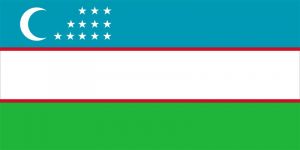Language/Southern-uzbek/Grammar/Questions
Hi Southern Uzbek learners! 😊
In this lesson, we will learn how to form a question in Southern Uzbek. Asking questions is an important part of communication, and being able to ask questions will help you better understand the language of the Southern Uzbek people. We will explore how to form yes/no questions and information questions, and provide examples using vocabulary related to everyday life.
Don't hesitate to look into these other pages after completing this lesson: Future Tense, Conditional Mood, Negation & Give your Opinion.
Yes/No Questions[edit | edit source]
Yes/no questions are used to confirm or deny a situation, and can be formed by using question particles, or by inverting the word order of a statement. Let's take a look at each method.
Using Question Particles[edit | edit source]
Question particles are added to the end of a statement to form a question. There are 2 particles which are commonly used in Southern Uzbek: «ми» and «у?». Let's see an example:
| Southern Uzbek | Pronunciation | English |
|---|---|---|
| Сиз менинг аптекада жойингизми? | Siz mening aptekada joyingizmi? | Are you at my pharmacy? |
In this example, the statement "Siz mening aptekada joyingiz" ("You are at my pharmacy") becomes a question by adding the question particle «ми» to the end of the statement.
Another question particle that can be used is «у?». It can be added to the end of a sentence to form a yes or no question. Here is an example:
| Southern Uzbek | Pronunciation | English |
|---|---|---|
| Решка тўлдинми у? | Reshka to'ldinmi u? | Did you pay with coins? |
In this example, the statement "Reshka to'ldingiz" ("You paid with coins") becomes a question by adding the question particle «у?» to the end of the statement.
Inverting Word Order[edit | edit source]
Another way to make a yes/no question is to invert the word order of a statement. The word order for a statement in Southern Uzbek is subject-verb-object (e.g. "Siz kitob olasiz" - "You buy a book"). To form a yes/no question, the verb and subject are switched. Here's an example:
| Southern Uzbek | Pronunciation | English |
|---|---|---|
| Китоб оласизми сиз? | Kitob olasizmi siz? | Do you buy a book? |
In this example, the statement "Siz kitob olasiz" ("You buy a book") becomes a question by switching the verb and subject.
Information Questions[edit | edit source]
Information questions are used to obtain specific information. They can be formed using question words, such as who, what, where, when, why, and how.
When forming an information question, the question word is placed at the beginning of the sentence, followed by the inverted subject-verb order. Here are some examples:
| Southern Uzbek | Pronunciation | English |
|---|---|---|
| Ким уйда ёшади? | Kim uyda yoshadi? | Who lives in the house? |
| Нима овқат тўйди? | Nima ovqat tuydi? | What did you cook? |
| Қаёда қайда бўлади? | Qayda bo'ladimi? | Where will the meeting be held? |
| Қачон борамиз? | Qachon boramiz? | When are we going? |
| Нима учун келибсиз? | Nima uchun kelibsiz? | Why are you coming? |
| Ҳамма кўгангиз ача турганми? | Hamma ko'gangiz acha turganmi? | How are you all feeling today? |
The question words are:
- Ким (Kim) - Who
- Нима (Nima) - What
- Қаёда (Qayda) - Where
- Қачон (Qachon) - When
- Нима учун (Nima uchun) - Why
- Ҳамма (Hamma) - How
Practice Dialogue[edit | edit source]
Here's a dialogue to practice forming questions:
- Person 1: Кўйда кечаси нима ёқди? (Ko'ida kechasi nima yoqdi?) ("What did you have for dinner?")
- Person 2: Мен кебоб ёқдим. (Men kebob yoqdim.) ("I had kebab.")
- Person 1: Қўшнича билан ёқдингизми? (Qo'shnicha bilan yoqdingizmi?) ("Did you have anything else with it?")
- Person 2: Ҳа, соғай ёқдим. (Ha, sog'ay yoqdim.) ("Yes, I had salad with it.")
Conclusion[edit | edit source]
As you can see, forming questions in Southern Uzbek is relatively easy once you know the basic rules. Use the question particles or invert the word order to form yes/no questions. For information questions, use the question word followed by the inverted subject-verb order. With practice, you'll be forming questions like a native in no time!
To improve your Southern Uzbek Grammar, you can also use the Polyglot Club website. Find native speakers and ask them any questions!
Sources[edit | edit source]
Having concluded this lesson, consider checking out these related pages: Gender, How to Use Be & Plurals.

